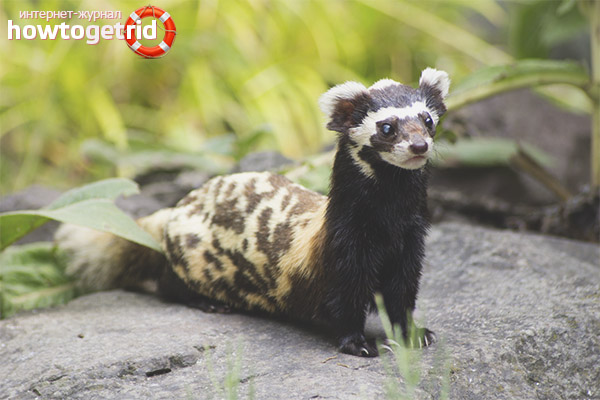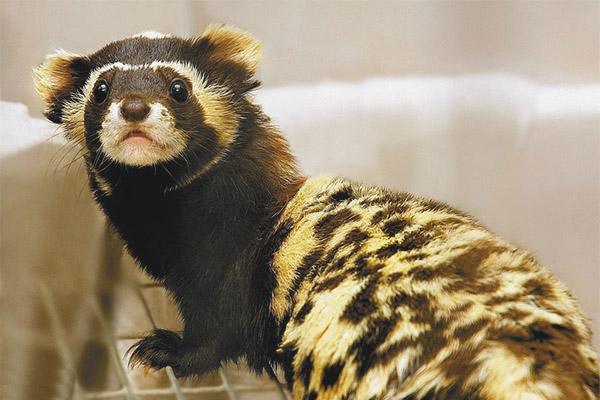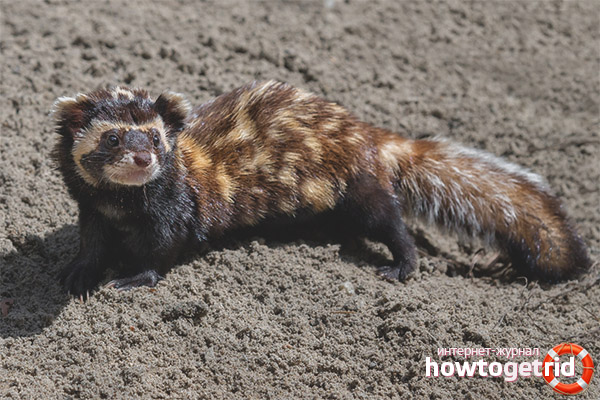The content of the article
The dressing is a predator, having a small size and appearance, much like a ferret. Unlike their close relatives, the ferret and affection, dressing is a rare animal.
Appearance
The size of the ligation is not impressive. The animal reaches 35-38 centimeters in length, and weighs only 500-700 grams. Male and female do not have obvious differences in appearance.
A special feature that distinguishes these animals is their non-standard coloring. The basis of the color is dark chestnut wool, but throughout the body in a chaotic manner are white, black and yellow blotches that form interesting patterns. The same patterns are transferred to the tail, which ends in a small tassel. The dressing fur is rather short and stiff, and this is the cause of constant ruffling in the animal.
The muzzle is small and short. The ears of the dressing are very large, covered with white fur. Because of the excessively short legs for the body so long, it seems that the animal is constantly pressed to the ground, and as if sneaking.
Habitat
The main distribution of dressings are in the territories of Eastern Europe and Asia. Starting from the Balkans, through the south of the Russian Federation up to Mongolia and northwestern regions of China. Animals prefer to settle in areas with as few trees as possible. For example, steppe or desert. Very rare, but still occur in the mountains. Also, sometimes they can settle in parks and gardens.
Lifestyle and nature of dressings
Males ligation prefer a single lifestyle.They come into contact with females only during the mating season. In relation to other males are often very hostile. Dressings try not to allow foreign dressings on their territory.
When the animal is in grave danger, the ligation seeks shelter in a tree or in a burrow. But this is not always possible, and if the paths of retreat are cut off, the animal assumes a threatening posture, indicating that it is ready for battle. This pose is as follows: the animal throws its tail on its back, rises on its legs and makes the loudest growl. If this has not had any effect on the enemy, the ligation is forced to attack, spraying a vile-smelling liquid from the anal gland and, if necessary, using claws.
Hunting dressings
Small legs and oblong body allow dressings to hunt rodents in their own burrows. However, these hunting skills of animals are not limited. The structure of their bodies allows them to do this in trees just as effectively. Ligation has a rather poorly developed vision, therefore in hunting they rely more on their hunting sense of smell.
Sometimes ligation is able to cooperate with a fox to hunt for gerbil colonies. While the fox watches the gerbil at the entrance to their burrow, the dressing, meanwhile, battles them underground. This is a very remarkable fact, given the solitary lifestyle of these animals.
Bandages move in zigzags, leaving an uneven track with their short legs. Sniffs the area, and sometimes raising his head to inspect the terrain. If necessary, the animal rises on its hind legs, like meerkats, getting a wider view.
Ligation are sedentary. And if safety and food are all in order, then they are able to live their whole life on a piece of land. But if necessary, can migrate.
Power Features
Ligation refers to omnivorous animals, but they give the most preference to meat. The main victims of their hunt are gerbils, voles, ground squirrels and hamsters, which they exterminate in their own burrows and often live there. If there is a great need, the ligation can also cope with a bird or a snake, but this does not happen often.
A less preferred, but still possible food for dressing is eggs, berries, or fruits of trees, like apples or pears. Living in the gardens ligation does not disdain the flesh of melon or watermelon. But still the meat in the diet of this predator in priority.
Reproduction and life expectancy

Ligation has a fairly long period of life. In the wild, for example, they live up to 7 years, which is quite a lot for such a small predator.
The mating season takes place at the end of the summer, approximately starting in June and ending in August. It is at this time that the loving male begins to call females for mating. The ligation calls females, emitting an iridescent rumbling-cooing, to which the nearest female reacts, which has heard it. The mating process takes place rather quickly, after which the female leaves again, leaving the male to dress in solitude.
It is still not known by what criteria the males select a female for mating. Most likely only the location has an effect. The closer the female’s habitat is to the male, the more likely it is that they mate in the mating season.
Feeding young stock lasts about 40 days, even after two weeks of dressing are sent to an independent life. Males usually take part in raising young.
Dressing and man
At the beginning of the 20th century, the bandaging population was under threat. Due to the development of the agrarian industry, the re-plowing of fields, and the destruction of rodents, the dressings were on the verge of extinction. Without a good fodder base it is very difficult to live by sight. The animal is listed in the red book and is now very rare.
Video: dressing (Vormela peregusna)












To send